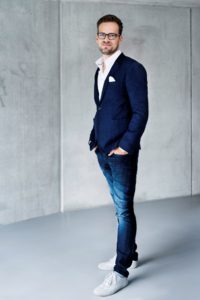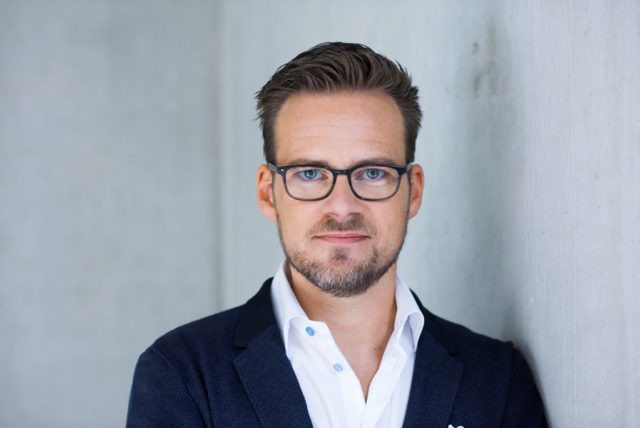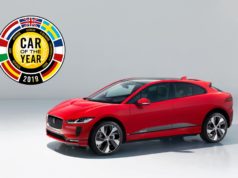Christian Bauer took over as Head of Interior Design MINI in June 2017. In his answers to the following ten questions, he explains what it is that makes interior design, in particular, an immensely challenging job, why automotive design is on the verge of perhaps one of its biggest ever paradigm shifts and what role MINI will play in this process.
1. Why did you become a car designer?
The job is both a vocation for me and a tremendous privilege because as designers we have the opportunity to make the world a more beautiful place. Even as a child, there were two things that I loved: cars and drawing. I had a huge collection of Matchbox cars. I also had the good fortune to be constantly surrounded by real vehicles, too, as my father spent a great deal of time “tinkering” with various models. And I’ve always really enjoyed drawing as well. So, combining the two passions and making a career of them seemed like a logical thing to do, and the opportunity to study Transportation Design at the University of Applied Sciences in Pforzheim provided the ideal stepping stone into the profession.
2. What sort of things capture your imagination?
Development, the future – basically I’m fascinated by anything that’s new. I can’t bear the thought of things just standing still, and nothing good comes of it in the long term, in my view. Advancement is part of human nature, and it’s something we all engage with from a very young age; my own children show me time and again what a joy it is. Their delight in achieving or understanding something for the first time is communicated openly and directly. The pleasure taken in one’s own positive evolution is a source of both motivation and fascination for me: I, too, constantly challenge myself in order to keep progressing and creating new things.
3. What inspires you?
I draw inspiration from the unusual and the unseen. Every time someone successfully takes a new approach, I am reminded that we sometimes stick too closely to the familiar. New approaches often set new standards too. So, it’s worth breaking new ground, even if it means surmounting many obstacles and showing real courage. I am inspired by achievements in all sorts of disciplines – from architecture to biology and physics, to design, of course. A great deal of interdisciplinary work is being carried out at present, which can have a great bearing on design. For instance, you have biologists working together with engineers on intelligent materials. In future, it could be possible for surfaces such as leather, fabric or wood to communicate using light, sound or movement, for example. Functions and components will merge into one, opening up entirely new possibilities in the process.
4. What do you think of as good design?
For me, good design is always a reflection of the zeitgeist at the time, while also relating extremely closely to the person the product is geared towards. The way we see things – and, as a consequence, prevailing tastes – change over time. The dominant element in design today, for example, is clarity because the world we live in has become highly complex and we’re overloaded with input. That doesn’t necessarily mean that good design always has to mirror contemporary preferences, however: there is also such a thing as timeless design. All in all, good design must offer added value in my opinion – both functionally and emotionally.
 5. What do you like most about your work as a car designer?
5. What do you like most about your work as a car designer?
For me, design means far more than just the aesthetics of form; I see it as something carried out for and with people. This means that design always generates added value that satisfies at least one requirement of people or customers – even if it is “just” their sense of wellbeing. In other words, design helps to make life better. Playing an active role in that is something I am very proud of.
I also love the aspect of foresightedness, i.e. fathoming out the needs that people will develop in future and how we can best address them. This visionary role allows design to act as the driving force behind technological innovations and even inspire developers. That’s one of the most exciting and captivating parts of my job.
6. When it comes to car design, people tend to think first of the exterior design, rather than the interior. Why is that?
The exterior forms the first touchpoint with a vehicle. It’s the first thing you see and it generates direct emotions. The exterior’s styling confers certain attributes on the vehicle, such as power, speed or agility, which add up to give it a distinctive character. And it is not uncommon for the product to make a statement by clearly conveying the status and character of its driver. The exterior design is extremely important. But what keeps the customer hooked in over the long run – as many studies have confirmed – is the interior.
7. What is so special about interior design?
The real acid test as far as the customer is concerned comes when they actually get inside the car – and getting this right is a far tougher task. If you don’t feel at ease in the vehicle, can’t get to grips with the controls, don’t like the materials or think the build quality is abysmal, then you’re highly unlikely to buy another car from the same brand.
An interior designer has to be adept at a host of different disciplines
You need to know the basics of ergonomics, human behaviour, acoustics, control logic, and far more besides. The person must not feel restricted in their movement in any way. But at the same time, they must be guided and harnessed. They must not be dazzled by anything and yet everything must be clearly identifiable. And all of that not just in a single specific situation but throughout the whole spectrum of different movement scenarios and usage cases – from configuring the car on a smartphone to getting in and the actual driving, to getting out again.
And, of course, it must all be easy and intuitive to use. Then comes the icing on the cake. The styling of the surfaces, the coherent appearance of the parts, the overall effect of the interior. It should also be pointed out that we work within a pretty tight set of technical constraints, such as rigidity, crash characteristics, sound insulation, wiring harnesses and material wall thicknesses. These constraints have to be manipulated in such a way that there is more room and freedom for the actual task of design. And rest assured that there will always be something in the way.
Sculpting a line or a surface cleanly enough so that it doesn’t just look like covering for the technical constraints is quite a challenge in itself. The art of interior design resides in firing the emotions and creating a feel-good factor while working within all these complex parameters. The feeling when the Board of Management signs off a production-car interior with a broad smile on their faces is indescribable and a real reward for all the effort involved.
8. What do you see as being the key issues of the future for MINI and what role will interior design have to play?
There is a great deal of upheaval in the automotive world at present. We are seeking to create a sensible and emotionally engaging product offering for smaller models in the premium segment against the highly complex backdrop of digitalisation, autonomous driving and, of course, electric mobility. At MINI we want to be an active player in pushing ahead this transition to the new world, as it were. In the course of this evolution, interior design is set to play an absolutely essential role. Enjoying a pleasant, flexible environment for the drive from A to B is becoming more and more important.
Autonomous driving will transform vehicle interiors. For many people, their vehicle will become a second living space after their homes. We will probably continue to spend a great deal of time in our cars in future. Perhaps even more than we do today. But we will increasingly be able to do other things there as well. Read, sleep, buy things online or play with the kids; the possibilities seem endless. Vehicle interiors must, therefore, take new forms of usage into account. And we as interior designers have the ability to create completely new worlds and experiences and take quality of life to a whole new level. This is where I expect to see perhaps the biggest paradigm shift in car manufacture.
9. How will that look at MINI exactly?
MINI is all about maximising the experience within the smallest possible footprint. The technical requirements of electric mobility mean that installation spaces and partitioning have to be rethought. This opens up tremendous potential for MINI. Interaction with vehicles will assume an increasingly important role, as well. In future, customers will still be able to find their way around a MINI instantly and purely by intuition. MINI will show that interaction does not have to be boring, look overly technical or be complicated to use. What is important is that, in future, anyone who gets into a MINI will still feel totally at ease. And ideally, they won’t want to get out again either.
10. What would the perfect interior of the future look like for you?
I think – and, indeed, hope – there is no such thing as “the” perfect interior. Otherwise, we would be out of a job! In the future, there will certainly be a far higher degree of flexibility and fusion between all the areas involved, such as materials, displays, movement, sound, aroma and control. I’m excited about what lies ahead. And I hope designers and engineers alike will get the freedom they need to bring about something completely new.
Christian Bauer has been Head of Interior Design at MINI since June 2017. Before switching to MINI, the 43-year-old was in charge of Interior and Detail Design at BMW i. Prior to that, he worked as both team manager and acting general manager in BMW Interior Design and Detailing.
Follow our Instagram page for even more MINI action. https://t.co/4w1VqcmTMU. #MINILove Photo by vincent.patrizi. pic.twitter.com/Jhg14WwgyE
— MINI (@MINI) February 12, 2018

































